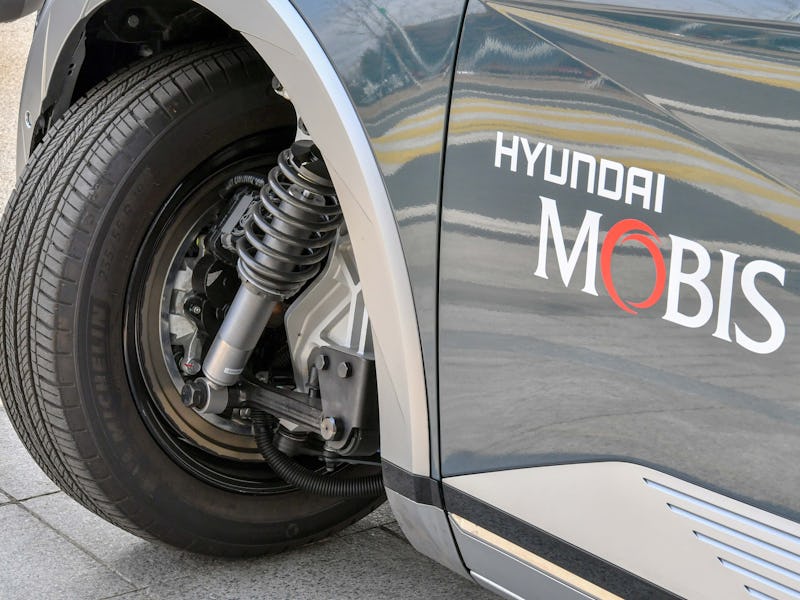Hyundai’s Crab-Walking Cars Make Parallel Parking A Breeze
Backing into a parking spot could soon be a thing of the past.

Backup cams be damned, Hyundai’s individually articulating wheels are the next big tech to make parallel parking easier. Hyundai and its subsidiary Hyundai Mobis say it’s developed an “In-Wheel Drive System” that allows independent control of each wheel on an EV.
Hyundai has been working on this mechanism for a while, but the Korean automaker says it’s actually testing it on EVs now, according to a report from UPI. We first saw Hyundai show off the impressive maneuverability on a prototype Ioniq 5 at CES 2023.
Hyundai has been testing its In-Wheel Drive system on its Ioniq 5 models.
At the time, the company didn’t offer any timelines on when this in-wheel system would be introduced into production cars. Now that Hyundai is testing its technology in its EVs, that could mean we’ll be seeing these individually articulating wheels on the road soon. Here’s what we know about Hyundai’s system so far.
WHAT DOES HYUNDAI’S IN-WHEEL DRIVE SYSTEM DO?
The In-Wheel Drive System means you get to independently control each of the four wheels through a separate in-wheel motor. This system cracks open a car’s maneuverability since you have many more options than just driving in a straight line.
For parallel parking, you can turn each of the four wheels 90 degrees and slot in from the side instead of backing into a spot. For narrow or tight spaces, you can adjust the angle of your wheels to drive diagonally. Even if you have limited space, you can pull a U-turn on a dime by simply rotating 180 degrees. Hyundai’s demo shows off all of these different maneuvers, which would make driving in a city a lot more manageable.
WHAT ARE THE BENEFITS OF THE IN-WHEEL DRIVE TECHNOLOGY?
The most obvious benefit of Hyundai’s In-Wheel Drive System is saying goodbye to tricky parallel parking spots where you have to back up. You could even spin around in your driveway, so you never need to pull out by reversing.
Besides making your life easier, the technology improves your EV’s range as well. According to Hyundai, the system allows the wheels to be more efficient with better torque distribution to each wheel’s motor. Hyundai says the system improves turning and power efficiency by approximately 20 percent. This hidden benefit would be a huge upgrade to Hyundai’s Ioniq 5’s range which maxes out at 303 miles.
WHEN WILL HYUNDAI RELEASE CRAB WALK TECH?
Hyundai says it’s been developing this technology since 2010. It eventually debuted its In-Wheel Drive System at CES 2018, before showing off a demo at the latest CES. The demo on a prototype Ioniq 5 looks like the technology was close to being production-ready. The latest news that Hyundai is testing it on EVs is a huge step forward toward commercialization.
Hyundai is looking to complete the development of its system by the end of the year.
Oh Heung-sub, senior vice president of Hyundai Mobis, said in a press release that the company is planning to complete the development of its In-Wheel Drive System by the end of the year. After that, the company is planning to get it ready for mass production.
WHAT’S THE COMPETITION UP TO?
Hyundai isn’t the only car company to look into this technology. GMC already introduced its Hummer EV which can crabwalk up to 10 degrees in either direction and is planning to insert that same technology into its Sierra EV pickup. Tesla is also planning to incorporate crab walking capabilities into its Cybertruck whenever it releases. On a less advanced scale, Mercedes-Benz has offered its rear-axle steering technology on a few of its higher-end models, like its AMG EQE SUV.
None of these offerings are on the same level of articulation as Hyundai’s In-Wheel Drive System, though. It could be a while until we see Hyundai’s tech incorporated into production models, but once it does, it will be a major advantage over its competitors.
This article was originally published on